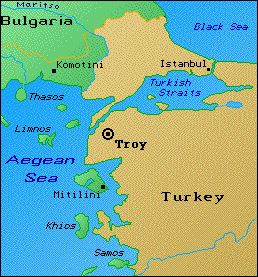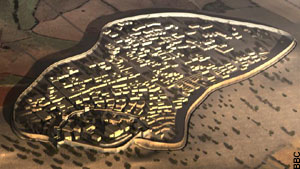Current Criticism and Conception of Troy

In April of 2004, The Telegraph , a reputable newspaper in Great Britain printed a story on Troy—the questions raised by this amazing city, the skeptics and the believers. Taking as objective a view as possible, reporter Aidan Laverty, attempted to extract the facts and piece together the mystery of Troy as is still perplexes archeologists today, while asking the question of why we even care about a city that might be false.
The city of Troy (Troy VI-VIIa) which Homer speaks of in his epics, The Iliad andThe Odyssey , lasted from 1800 until 1250 B.C.E. In his writings, Homer described Troy using standard epithets - a "well-walled," "broad" city with "lofty gates" and "fine towers," one capable of holding a large population. Unfortunately, these descriptions have no unique value to historians; his descriptions are simply stock phrases and are not to be taken seriously. ( Wilson , 1998)
The legend of Troy and Homer's Iliad have maintained an enduring grip on students of all ages and disciplines including Classics, English, History and Archeology to name a few—but what keeps the insatiable desire to know alive? The legend appeals to imagination as much if not more than it does to logic—so why, particularly, are scientists so obsessed? Laverty pieces together the history with scientists, while also examining the future of this search—is there a future? Scientists argue yes, undeniably. There is a future for this search, and some scientists even go so far as to say they can prove that a siege—similar to the one described in Homer's lliad —did indeed take place.
In 1893 an excavation led by Schliemann's former assistant, Wilhelm Dörpfeld, began to uncover a very different Troy . Dörpfeld excavated a citadel with massive walls, with high towers and great gates. This citadel was from the late Bronze Age, a time that fitted the legend.
The city had physical features that seemed to match the myth. For instance, Homer had described how the warrior Patroclus was able to scale the walls of Troy because they were built at an angle. Sections of the defensive walls that Dörpfeld uncovered were indeed sloping. Once again, some archaeologists declared that this was the city of legend.
But Dr Cline points out that there was one important feature of the city that didn't match the myth. Homer's Troy was big enough to withstand a siege that lasted 10 years. The city that archaeology had uncovered just wasn't that big: "It is a small place, it's just a citadel that they had found, and a couple of hundred people up there maybe at the most, and the critics said this is not Troy , Troy must be big, Troy must be huge if Homer was right."
The next excavation, led by Carl Blegen, an American, finished at Troy in 1938. For 50 years the site lay untouched, and the question of whether it really was the city of legend remained unresolved.

In 1988 work at Troy resumed under the leadership of Professor Manfred Korfmann of Tübingen University . He assembled a large, international team, drawing on a wide range of scientific disciplines.
Korfmann said he wasn't interested in the myth. He was drawn to Troy because it had been inhabited for more than 3,000 years and occupied an important strategic position between Asia and Europe . Its long archaeological record allows it to be used as a reference site, to date finds from elsewhere. But he has found evidence that offers a dramatic new insight into the legend.
When Korfmann arrived at Troy he was puzzled to discover that the city's great gateways appeared to have no means of being secured shut. "The gate is open, inviting everyone to come in. We walked up and down a hundred times and wondered how it was closed, how it was blocked. How could they defend themselves?"
He knew that if the gates couldn't be blocked, there must have been some other outer line of defences. His hunch was that there must have been more to Troy than had so far been uncovered.
He began to excavate outside the citadel walls and unearthed substantial buildings from the late Bronze Age, from between 1700 and 1200 bc. These were from the same time as the citadel that Dörpfeld had uncovered. Korfmann wondered if these buildings were the beginning of a lower city, a settlement that spread outside the citadel walls. But the area it might have covered was so vast that it would be impossible to excavate with shovels.
Korfmann asked his colleagues for a magnetic scan of the area: geophysics scans can detect changes in the Earth's magnetic field, revealing buried walls, streets and buildings.
In this case, the scans revealed a grid of wide streets and avenues beneath the fields outside the citadel walls. It was obvious that this belonged to a much later period than the late Bronze Age, to classical Greek and Roman times.
But there was no sign of a city from the late Bronze Age, from the time when the siege is said to have happened. Then Prof Korfmann noticed a faint line on the scan that traced a wavy path around the citadel. It was very different from the regular grid of Greek and Roman streets. It was time to dig.
He uncovered part of a wide ditch cut into the rock and has traced its path for 700 metres. It's from the late Bronze Age, the time of the legend. He believes it was designed to stop enemy chariots, and so marked the outer limit of the lower city.
He estimates the population of the city that lay behind the outer defences in the late Bronze Age as between 4,000 and 8,000. Troy was more than just a citadel of a few hundred people. "People who think there was a Homeric Troy - a city of substantial size and population - will be happy with this result," he says.
Dr Cline comments: "Korfmann may have just put the nail in the coffin of the doubters."
In the myth, Troy is razed by the army of Agamemnon. The early archaeologists believed the city might have been destroyed between 1200 and 1300 BC either by fighting or by an earthquake. Now, with access to the lost lower city, Prof Korfmann has discovered evidence that it suffered a catastrophe at around 1200 BC.
"There are skeletons. We found for example a girl, I think 16 years old, half buried. The feet were burnt by fire and half of the corpse was buried underground. This is strange, so rapid a burial within a public space within the city."
He also found arrowheads, which suggested close-quarter fighting. But a key clue to the fate of Troy came from collections of slingshots that he discovered. These were an important weapon of the time, used to keep enemy archers at bay. Korfmann believes that finding them in piles is significant. If the defenders had won the battle they would have taken the slingshots to be used elsewhere, for example by shepherds in the fields.
Hence, Korfmann believes, the Trojans must have lost the battle. “It was a city that was besieged. It was a city that defended itself. They lost the war and were obviously defeated.”
In this way the archaeological record backs the claim of the legend that Troy was destroyed by an enemy army at the end of the Bronze Age. But was it a Greek army as the legend says?
“We do not know, because the attacker rarely leaves any remains if he's successful.” (Laverty, 2004)
Works Cited
Wilson, Samuel M. The Archaeology Archive . U of Texas . May 1998. <http://www.utexas.edu/courses/wilson/ant304/projects/projects97/bairdp/homer.htm
Laverty, Aidan. “The truth about an epic tale of love, war and greed”. March 24, 2004. <http://www.telegraph.co.uk/connected/main.jhtml?xml=/connected/2004/03/24/ecftroy24.xml>